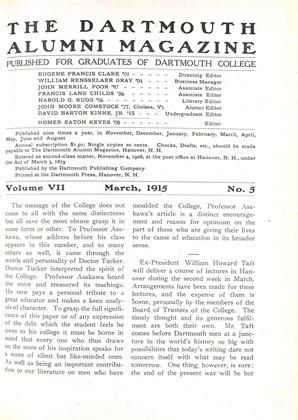During February, the hockey team, through a defeat at the hands of Yale, was unable to secure more than a divided championship in the intercollegiate league. The basketball team fared even worse, losing even to Pennsylvania, the only other contender for last place in the league.
Massachusetts Tech was the fifth opponent of the Green seven, and in a slow game on Alumni Oval, lost to Dartmouth 4-1. The loss of Wanamaker on account of sickness was a serious handicap to the team work of the Green seven, whose strength seemed to lie in the goal tending of Donahue. The play was ragged through the softness of the ice, which practically made fast play impossible,
The Yale game at New Haven, which resulted in a 4-1 victory for the Blue, required two extra periods before the 1-1 tie could be broken. The victors relied upon the slashing football type of hockey, against which the smoother Canadian game of the losers made little headway. Captain Tuck and Murchie starred for Dartmouth, and Murray and York excelled for Yale. As a result of Yale's victory, a triple tie in the intercollegiate league was created, which was later complicated further through Yale's defeats by Harvard.
The Bishops College game was fast, at least, with the victory for Dartmouth 4-2. The superiority of the Green teamplay was noticeable throughout the game, although the Bishops team showed itself a well-coached and speedy combination. Captain Tuck was easily the star of the game, while Wanamaker showed flashes of his real form.
Dartmouth closed the season in Boston with a game with the St. Nicholas hockey club of New York, which the Green's opponents won 4-1. The Green's lack of practice proved disastrous, but the game was fast throughout. The best play was during the first half, since the Dartmouth seven appeared to tire in the second period, allowing St. Nicholas to score the three winning points.
Dartmouth was uniformly unsuccessful in basketball, failing to win any of the intercollegiate games. On February 5, the Green five lost the first game of a trip to Columbia and Annapolis, to Columbia, 28-24. The Green, as shown by the score itself, contested the game throughout but the lead that Columbia obtained in the first half was sufficient to win the game. The Navy game on the following evening was even more disappointing, with the Annapolis five the victors by a 40-12 score. The Green team failed to show any signs of the improvement that had been visible the preceding evening, and basket-shooting was the main flaw. In the single Winter Carnival game, Dartmouth lost to Yale 31-29, in the most encouragaing game of the season. Real basket-shooting appeared noticeable for the first time, but the Green's tendency to foul proved its nemesis. On February 17, Princeton was the selected victor in a game featured by close guarding, which the Tigers won 18-13. In the first half, the Green five held the league runnersup to a tie score, but this disappeared in the second half. In Philadelphia, Pennsylvania won a close game 19-18. The main causes of the defeat were Winship's inability to cage fouls, and McNichol's work at guard for the Red and Blue. The seventh league defeat for Dartmouth was also administered by Pennsylvania on the home floor, 37-22. Dartmouth led in the earlier part of the contest, but failed to show any semblance of form in the second period. The team enters upon the closing throes of the season in March, with contests scheduled with several of the strong championship contenders.
The announcement of a renewal of relations with Brown signalized the opening of the intercollegiate track season. Dartmouth carried away the dual relay race at Providence easily. In the B. A. A. games, the Green gained little glory, .the two-mile four proving to be the only successful relay team. Trenholm secured a second in the 45-yard hurdles, but Whitney, Spears, and Siemsen all failed to place.
 View Full Issue
View Full Issue
More From This Issue
-
 Article
ArticleWILLIAM JEWETT TUCKER
March 1915 By Kan-Ichi Asakawa '99 -
 Article
ArticlePROBLEMS IN PREPARATORY SCHOOL ATHLETICS
March 1915 By Walter H. Lillard '05 -
 Article
ArticleThe message of the College does not come to all with the same distinctness
March 1915 -
 Article
ArticleALUMNI PUBLICATIONS
March 1915 -
 Class Notes
Class NotesLOCAL ASSOCIATIONS
March 1915 -
 Article
ArticleTWO MEN OF DARTMOUTH
March 1915 By William Byron Forbush '88








